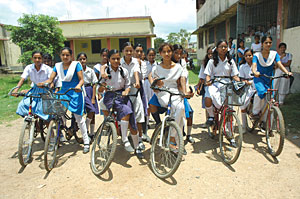 |
In 2005, Bihar's annual budget was INR 40 billion. This year it has reached INR 240 billion. In 2005, 2.5 million children were not enrolled in schools, the number has dropped to 730,000 this year. In 2004-2005, the state built only 385km roads, in the last fiscal year alone it has built 3,500 km of roads and 312 bridges. Bihar was once notorious for crime and political violence. Today, not only Patna even cities in the hinterland have seen sharp decrease in crime.
To be sure, Bihar still faces a lot of challenges. But if these indicators are anything to go by, the state's chief minister Nitish Kumar is set to use Bihar's blistering growth rate of 11.5 per cent to good use in improving infrastructure, ensuring social equity and controlling crime.
 Volunteers filling the nutrition form. The Bihar government runs a nutrition campagin to tackle child malnourishment in the state. |
In the education sector, the Bihar government is trying to improve girls enrollment by improving accessibility, affordability and awareness among rural folk. It has invested in upgrading 15,000 primary schools to secondary level, and parents are given cash incentives to send their daughters to school. So far, 1.36 million girls have got free school uniforms, shoes, and bicycles. (pictured, above)
Bihar is the second fastest growing state in India, but the backlog of past decades of corruption and bad governance means there are still serious challenges ahead. "Bihar did not have bad governance, it had no governance," Nitish Kumar likes to say. The state faces an acute electricity shortage, and protests against power cuts in April spilled out into the streets with people blocking roads and attacking government offices across Bihar.
 Newly elected members of the Gram Panchayat in Baishali. Bihar has 50 per cent reservations for women in local bodies. |
Bihar has a long way to go before it can claim to be a prosperous state, but the winds of change are blowing south of Nepal's border.
Read also:
Left behind
Going the Bihar way, EDITORIAL
Glimpses of Bihar, ANURAG ACHARYA
When there is so much to do to catch up, progress can be slow
"We want to see Nepal develop"
What they don't tell you, PRAFFUL KUMAR SINGH
The Nitish Kumar government has indeed transformed Bihar in the last five years. But we have to de-construct this success story.


